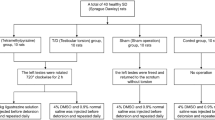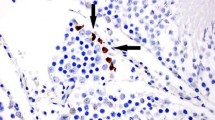Abstract
Purpose
The aim of this study was to investigate the impacts of gradual low-flow reperfusion postconditioning (GLFRP) on testicular ischemia–reperfusion injury (IRI).
Methods
A rabbit testicular ischemia model was established, and rabbits were divided into mild ischemia groups (the IRm, IPm1, IPm2, IPm3, and IPm4 groups) and moderate ischemia groups (the IRM, IPM1, IPM2, IPM3, and IPM4 groups). The IRm and IRM groups underwent direct reperfusion. The IPm1 and IPM1 groups, and the IPm3 and IPM3 groups, received 45 and 30 s maintained low-flow reperfusion. The IPm2 and IPM2 groups, and the IPm4 and IPM4 groups, were subjected to 45 and 30 s gradual low-flow reperfusion. The SOD and Johnsen’s score of testicular tissue on the surgical side 3 days after reperfusion were determined.
Results
The SOD activities in the IP3 and IP4 groups were higher than those in the IR, IP1, and IP2 groups (P < 0.05), and those in the IP4 group were higher than those in the IP3 group (P < 0.05). The Johnsen’s score in the IPm4 group was higher than that in the other groups (P < 0.05), those in the IPM groups were higher than those in the IRM group (P < 0.05), and those in the IPM3 and IPM4 groups were higher than those in the IPM1 and IPM2 groups (P < 0.05).
Conclusions
GLFRP could effectively reduce testicular IRI.


Similar content being viewed by others
References
Elshaari FA, Elfagih RI, Sheriff DS, et al. Oxidative and antioxidative defense system in testicular torsion/detorsion. Indian J Urol. 2011;27:479–84.
Rashed FK, Ghasemi B, Deldade Mogaddam H, et al. The effect of erythropoietin on ischemia/reperfusion injury after testicular torsion/detorsion: a randomized experimental study. ISRN Urol. 2013;2013:351309.
Zhao ZQ, Corvera JS, Halkos ME, et al. Inhibition of myocardial injury by ischemic postconditioning during reperfusion: comparison with ischemic preconditioning. Am J Physiol Heart Circ Physiol. 2003;285:H579–88.
Shimizu S, Saito M, Kinoshita Y, et al. Ischemic preconditioning and post-conditioning to decrease testicular torsion-detorsion injury. J Urol. 2009;182:1637–43.
Zhang Y, Xue ES, Lin LW, et al. Ischemic postconditioning reduces testis ischemia-reperfusion injury in rabbits. Zhonghua Nan Ke Xue. 2011;17:115–20.
Gao X, Ren C, Zhao H. Protective effects of ischemic postconditioning compared with gradual reperfusion or preconditioning. J Neurosci Res. 2008;86:2505–11.
Vinten-Johansen J, Shi W. Preconditioning and postconditioning: current knowledge, knowledge gaps, barriers to adoption, and future directions. J Cardiovasc Pharmacol Ther. 2011;16:260–6.
Zhang GM, Wang Y, Li TD, et al. Gradual algorithm of postconditioning reduced reperfusion injury through mitochondrion pathway in rats. Zhonghua Xin Xue Guan Bing Za Zhi. 2010;38:539–44.
Yuluğ E, Türedi S, Alver A, et al. Effects of resveratrol on methotrexate-induced testicular damage in rats. Sci World J. 2013;2013:489659.
Liang RX, Xue ES, Lin LW, et al. Correlation between sonographic appearance of experimental testicular ischemia and histological changes of the testis after reperfusion. Zhonghua Nan Ke Xue. 2009;15:115–21.
Lu D, Kassab GS. Role of shear stress and stretch in vascular mechanobiology. J R Soc Interface. 2011;8:1379–85.
Lund T, Hermansen SE, Andreasen TV, et al. Shear stress regulates inflammatory and thrombogenic gene transcripts in cultured human endothelial progenitor cells. Thromb Haemost. 2010;104:582–91.
Lysiak JJ, Nguyen QA, Turner TT. Fluctuations in rat testicular interstitial oxygen tensions are linked to testicular vasomotion: persistence after repair of torsion. Biol Reprod. 2000;63:1383–9.
Nemlin C, Benhabbouche S, Bopassa JC, et al. Optimal pressure for low pressure controlled reperfusion to efficiently protect ischemic heart: an experimental study in rats. Transplant Proc. 2009;41:703–4.
Tsang A, Hausenloy DJ, Mocanu MM, et al. Postconditioning: a form of “modified reperfusion” protects the myocardium by activating the phosphatidylinositol 3-kinase-Akt pathway. Circ Res. 2004;95:230–2.
Sakurai M, Nagata T, Abe K, et al. Oxidative damage and reduction of redox factor-1 expression after transient spinal cord ischemia in rabbits. J Vasc Surg. 2003;37:446–52.
Lu K, Liang CL, Chen HJ, et al. Injury severity and cell death mechanisms: effects of concomitant hypovolemic hypotension on spinal cord ischemia-reperfusion in rats. Exp Neurol. 2004;185:120–32.
Serviddio G, Di Venosa N, Federici A, et al. Brief hypoxia before normoxic reperfusion (postconditioning) protects the heart against ischemia-reperfusion injury by preventing mitochondria peroxyde production and glutathione depletion. FASEB J. 2005;19:354–61.
Akçora B, Altuğ ME, Balci A, et al. Gradual detorsion of torsioned rat testis attenuates ischemia reperfusion injury. J Pediatr Surg. 2008;43:1879–84.
Sun HY, Wang NP, Kerendi F, et al. Hypoxic postconditioning reduces cardiomyocyte loss by inhibiting ROS generation and intracellular Ca2+ overload. Am J Physiol Heart Circ Physiol. 2005;288:H1900–8.
Shi J, Liu Y, Duan Y, et al. A new idea about reducing reperfusion injury in ischemic stroke: gradual reperfusion. Med Hypotheses. 2013;80:134–46.
Ozmen S, Ayhan S, Demir Y, et al. Impact of gradual blood flow increase on ischaemia-reperfusion injury in the rat cremaster microcirculation model. J Plast Reconstr Aesthet Surg. 2008;61:939–48.
Lee JH, Kim K, Jo YH, et al. Gradual and stepwise increase of blood pressure in hemorrhagic shock: mimicking ischemic post-conditioning. Med Hypotheses. 2013;81:701–3.
Conflict of interest
None.
Animal rights statement
All institutional and national guidelines for the care and use of laboratory animals were followed.
Author information
Authors and Affiliations
Corresponding author
About this article
Cite this article
Xue, E., Guo, J., Huang, M. et al. Effects of gradual low-flow reperfusion postconditioning on ischemia–reperfusion injury involving incomplete testicular torsion in rabbits. J Med Ultrasonics 42, 207–214 (2015). https://doi.org/10.1007/s10396-014-0591-3
Received:
Accepted:
Published:
Issue Date:
DOI: https://doi.org/10.1007/s10396-014-0591-3




